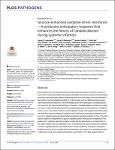Glucose-enhanced oxidative stress resistance—A protective anticipatory response that enhances the fitness of Candida albicans during systemic infection
| dc.contributor.author | Larcombe, DE | |
| dc.contributor.author | Bohovych, IM | |
| dc.contributor.author | Pradhan, A | |
| dc.contributor.author | Ma, Q | |
| dc.contributor.author | Hickey, E | |
| dc.contributor.author | Leaves, I | |
| dc.contributor.author | Cameron, G | |
| dc.contributor.author | Avelar, GM | |
| dc.contributor.author | de Assis, LJ | |
| dc.contributor.author | Childers, DS | |
| dc.contributor.author | Bain, JM | |
| dc.contributor.author | Lagree, K | |
| dc.contributor.author | Mitchell, AP | |
| dc.contributor.author | Netea, MG | |
| dc.contributor.author | Erwig, LP | |
| dc.contributor.author | Gow, NAR | |
| dc.contributor.author | Brown, AJP | |
| dc.date.accessioned | 2023-10-12T15:45:47Z | |
| dc.date.available | 2023-10-12T15:45:47Z | |
| dc.date.issued | 2023-07-10 | |
| dc.identifier.issn | 1553-7366 | |
| dc.identifier.issn | 1553-7374 | |
| dc.identifier.other | e1011505 | |
| dc.identifier.uri | https://pearl.plymouth.ac.uk/handle/10026.1/21403 | |
| dc.description.abstract |
Most microbes have developed responses that protect them against stresses relevant to their niches. Some that inhabit reasonably predictable environments have evolved anticipatory responses that protect against impending stresses that are likely to be encountered in their niches–termed “adaptive prediction”. Unlike yeasts such as Saccharomyces cerevisiae, Kluyveromyces lactis and Yarrowia lipolytica and other pathogenic Candida species we examined, the major fungal pathogen of humans, Candida albicans, activates an oxidative stress response following exposure to physiological glucose levels before an oxidative stress is even encountered. Why? Using competition assays with isogenic barcoded strains, we show that “glucose-enhanced oxidative stress resistance” phenotype enhances the fitness of C. albicans during neutrophil attack and during systemic infection in mice. This anticipatory response is dependent on glucose signalling rather than glucose metabolism. Our analysis of C. albicans signalling mutants reveals that the phenotype is not dependent on the sugar receptor repressor pathway, but is modulated by the glucose repression pathway and down-regulated by the cyclic AMP-protein kinase A pathway. Changes in catalase or glutathione levels do not correlate with the phenotype, but resistance to hydrogen peroxide is dependent on glucose-enhanced trehalose accumulation. The data suggest that the evolution of this anticipatory response has involved the recruitment of conserved signalling pathways and downstream cellular responses, and that this phenotype protects C. albicans from innate immune killing, thereby promoting the fitness of C. albicans in host niches. | |
| dc.format.extent | e1011505-e1011505 | |
| dc.format.medium | Electronic-eCollection | |
| dc.language | en | |
| dc.publisher | Public Library of Science (PLoS) | |
| dc.subject | Humans | |
| dc.subject | Animals | |
| dc.subject | Mice | |
| dc.subject | Candida albicans | |
| dc.subject | Glucose | |
| dc.subject | Oxidative Stress | |
| dc.subject | Neutrophils | |
| dc.subject | Saccharomyces cerevisiae | |
| dc.subject | Fungal Proteins | |
| dc.title | Glucose-enhanced oxidative stress resistance—A protective anticipatory response that enhances the fitness of Candida albicans during systemic infection | |
| dc.type | journal-article | |
| dc.type | Article | |
| plymouth.author-url | https://www.ncbi.nlm.nih.gov/pubmed/37428810 | |
| plymouth.issue | 7 | |
| plymouth.volume | 19 | |
| plymouth.publication-status | Published online | |
| plymouth.journal | PLOS Pathogens | |
| dc.identifier.doi | 10.1371/journal.ppat.1011505 | |
| plymouth.organisational-group | |Plymouth | |
| plymouth.organisational-group | |Plymouth|Faculty of Health | |
| plymouth.organisational-group | |Plymouth|Users by role | |
| plymouth.organisational-group | |Plymouth|Users by role|Academics | |
| plymouth.organisational-group | |Plymouth|Faculty of Health|Peninsula Medical School | |
| dc.publisher.place | United States | |
| dcterms.dateAccepted | 2023-06-22 | |
| dc.date.updated | 2023-10-12T15:45:34Z | |
| dc.rights.embargodate | 2023-10-13 | |
| dc.identifier.eissn | 1553-7374 | |
| dc.rights.embargoperiod | forever | |
| rioxxterms.versionofrecord | 10.1371/journal.ppat.1011505 |


